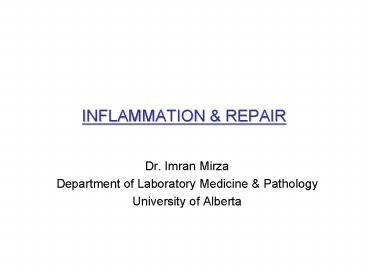INFLAMMATION - PowerPoint PPT Presentation
1 / 25
Title:
INFLAMMATION
Description:
List the characteristics and clinical manifestations of acute ... by administering adrenal corticosteroid hormones or other agents to reduce the tissue damage. ... – PowerPoint PPT presentation
Number of Views:431
Avg rating:3.0/5.0
Title: INFLAMMATION
1
INFLAMMATION REPAIR
- Dr. Imran Mirza
- Department of Laboratory Medicine Pathology
- University of Alberta
2
Learning Objectives
- List the characteristics and clinical
manifestations of acute inflammation - Describe the possible outcomes of an inflammatory
reaction - Compare infection and inflammation and describe
some of the terms used
3
Inflammatory Reactions
- A nonspecific response to any agent that causes
cell injury - Agents may be
- Physical (heat or cold)
- Chemical (concentrated acid)
- Microbiologic (bacterium or virus)
4
The Players
5
Local and Systemic Effects of Inflammation
6
(No Transcript)
7
(No Transcript)
8
Clinical Manifestations of Inflammation
- Heat and redness
- Dilated blood vessels and slowing of blood
through capillaries - Swelling
- Accumulation of fluid and exudate due to
extravasation of plasma - Tenderness and pain
- Irritation of nerve endings
9
Clinical Manifestations of Inflammation
10
Inflammatory Process
- Acute inflammatory process
- most important cell is the polymorphonuclear
leukocyte, an actively phagocytic cell - later the mononuclear cells (monocytes,
macrophages) that clean up the debris - Systemic effects become evident, i.e.
- feeling ill and ? temperature
- the bone marrow ? its production of leukocytes,
which ? in bloodstream - Mild inflammatory process it soon subsides,
tissues returning to normal (resolution)
11
Chemical Mediators of Inflammation
- The characteristic features of the inflammatory
reaction are not caused by the tissue damage
itself - They are caused by chemical agents (chemical
mediators) formed when tissues are damaged - Some mediators are derived from cells
- Some mediators are formed from proteins in the
blood plasma
12
Chemical Mediators of Inflammation
Mediators released from cells
Mediators (kinins) from plasma
Mediators from complement activation
13
Cell Derived Mediators
- Mast cells widely distributed throughout
connective tissue their cytoplasm is filled with
granules containing histamine (potent
vasodilator) - Prostaglandins (PG) synthesized by cells from
arachidonic acid present in cell membranes - Leukotrienes same as PG
14
Blood Plasma Mediators
- Bradykinins (kinins) their formation is
triggered by one of the proteins concerned with
blood coagulation. - Complement group of blood proteins, consisting
of 9 separate protein components, that are
activated when an antigen combines with an
antibody or by other ways that do not require
antigen-antibody reaction.
15
Harmful Effects of Inflammation
- The tissue injury results in part from the
injurious agent and in part to the inflammatory
reaction itself. - When the inflammatory reaction is not
self-limited and persists, it is necessary to
suppress it by administering adrenal
corticosteroid hormones or other agents to reduce
the tissue damage.
16
(No Transcript)
17
INFECTION
- An inflammatory process caused by disease
producing organisms - itis inflammation
- Cellulitis acute spreading infection at any site
- Abscess infection associated with breakdown of
tissue and formation of pus - Septicemia overwhelming infection where
pathogenic bacteria gain access to blood stream
18
INFECTION
19
INFECTION
- Relationship between the invading organism and
the defenses of the body - Many microbiologic agents are not harmful to
humans - The organisms that are capable of causing human
disease are pathogenic agents - Factors influencing the outcome
- Virulence of organism
- Numbers of invading organisms
- Resistance of hosts body (infected individual)
20
Factors Influencing Outcome of Infection
Course of Infection
Virulence and dosage
Body Defenses
Progressive disease
Resolution and healing
stalemate chronic infection
21
Factors Influencing Outcome of Infection
- Virulence of organism ease with which a
pathogenic organism can overcome the defenses of
the body - Highly virulent organism one that produces
disease in the majority of susceptible
individuals - Low virulence organism one that produces disease
only in susceptible individuals under favorable
conditions
22
CHRONIC INFECTION
- State in which the pathogenic organism and the
host are evenly matched - Relatively quiet, smoldering inflammation,
associated with repeated attempts of healing on
the part of the host - Lymphocytes, plasma cells, and monocytes are
predominant cells in chronic inflammatory process
23
INFLAMMATION
- http//www.muhealth.org/pharm204/inflammation.mov
24
Outcome of Inflammation
25
Bad spellers of the world, Untie!































